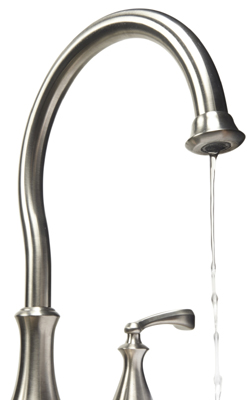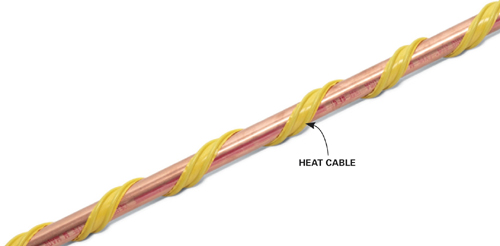
Let the water run
A tiny trickle from faucets protects pipes in two ways. First, it prevents pressure from building up inside pipes. Second, it creates a constant flow of water through pipes and that makes freezing much less likely.
A little ice can tear open a water supply line. That’s bad enough, but the real disaster often occurs as the ice thaws and water flows freely into your home. In just a few minutes, that flow can do thousands of dollars in damage.
When water freezes, it expands in volume by about 9 percent. And it expands with tremendous force: The pressure inside pipes may go from 40 pounds per square inch to 40,000 psi! No pipe can hold that much pressure, so it breaks open. The break may occur where the ice forms, but more often, it occurs where water pressure finds a weak spot in the pipe. That may be inches or even feet from the frozen area.

A tiny trickle from faucets protects pipes in two ways. First, it prevents pressure from building up inside pipes. Second, it creates a constant flow of water through pipes and that makes freezing much less likely.
The first sign of ice forming in pipes is reduced flow at faucets. So if the flow slows to trickle during a cold snap, or if you suspect your pipes are vulnerable, take action. Here are a few things you can do:
• Turn up the heat.
• Set up fans to blow heat into cold rooms.
• Open vanity or cabinet doors so warm air can reach the pipes under sinks.
• If you have exposed pipes inside closets or pantries, leave doors open.
• Disconnect garden hoses from outdoor faucets. Even “frost-proof” faucets can burst if a hose is connected.
• Keep the garage door closed.
• If you have reduced water flow, heat the most vulnerable pipes (usually in basements and crawl spaces or near exterior walls) with a hair dryer. Leave the faucet on while you apply heat. As you melt ice, the flow will increase.
Long-term freeze prevention is usually a major project, like insulating a crawl space, replacing standard outdoor faucets with frost-proof models or even rerouting pipes away from cold spots inside the home. Start by calling in a professional plumber to assess your situation and make recommendations.

Electric heat cable is good protection during cold spells. A thermostat switches on the heat only when the temperature drops, so heat cable won’t waste electricity when it isn’t needed. But if you need to protect lots of pipes for long periods, heat cable is an expensive solution.